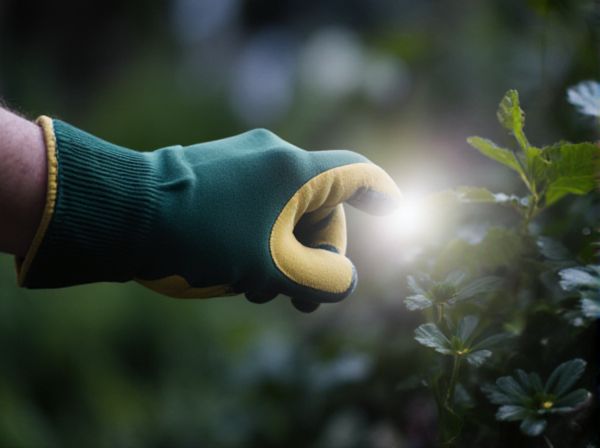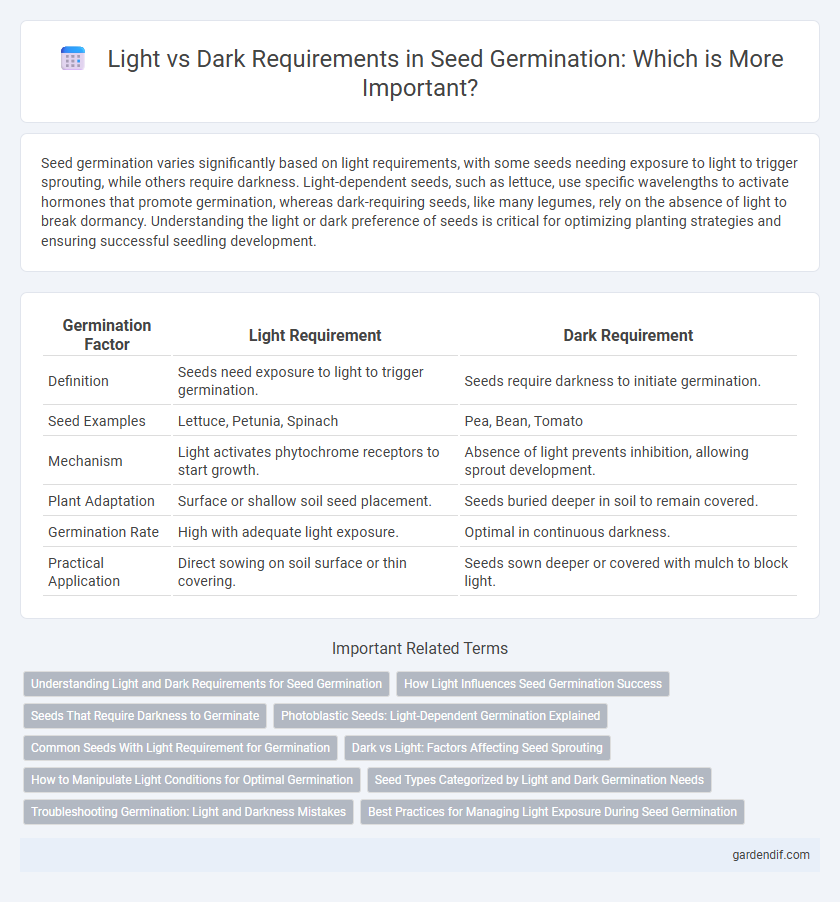
Light Requirement vs Dark Requirement Illustration
Seed germination varies significantly based on light requirements, with some seeds needing exposure to light to trigger sprouting, while others require darkness. Light-dependent seeds, such as lettuce, use specific wavelengths to activate hormones that promote germination, whereas dark-requiring seeds, like many legumes, rely on the absence of light to break dormancy. Understanding the light or dark preference of seeds is critical for optimizing planting strategies and ensuring successful seedling development.
Table of Comparison
| Germination Factor | Light Requirement | Dark Requirement |
|---|---|---|
| Definition | Seeds need exposure to light to trigger germination. | Seeds require darkness to initiate germination. |
| Seed Examples | Lettuce, Petunia, Spinach | Pea, Bean, Tomato |
| Mechanism | Light activates phytochrome receptors to start growth. | Absence of light prevents inhibition, allowing sprout development. |
| Plant Adaptation | Surface or shallow soil seed placement. | Seeds buried deeper in soil to remain covered. |
| Germination Rate | High with adequate light exposure. | Optimal in continuous darkness. |
| Practical Application | Direct sowing on soil surface or thin covering. | Seeds sown deeper or covered with mulch to block light. |
Understanding Light and Dark Requirements for Seed Germination
Seed germination is influenced by specific light and dark requirements that vary among species, with some seeds requiring exposure to light (photoblastic seeds) to trigger germination, while others need darkness (negative photoblastic seeds) to initiate growth. Light-sensitive seeds often contain photoreceptors like phytochromes that detect light quality and intensity, regulating germination through hormonal pathways such as gibberellins and abscisic acid. Understanding these light and dark cues is critical for optimizing germination conditions in agriculture and horticulture, ensuring successful seedling establishment.
How Light Influences Seed Germination Success
Light significantly influences seed germination success by triggering photoreceptors that activate hormonal pathways essential for embryo growth. Seeds of certain species, known as positive photoblastic seeds, require specific light wavelengths to break dormancy and initiate germination, enhancing cellular metabolic activities. Conversely, some seeds germinate better in darkness, where light-sensitive inhibitors remain inactive, demonstrating the critical role of light quality and duration in seedling emergence.
Seeds That Require Darkness to Germinate
Certain seeds, such as lettuce and pansy, require darkness to germinate effectively, relying on shaded or buried conditions to trigger sprouting. These dark requirement seeds exhibit inhibited germination when exposed to light, as light-sensitive phytochromes influence hormonal pathways that suppress growth. Understanding the necessity of darkness is crucial for optimizing agricultural practices and ensuring successful crop establishment in species with such germination traits.
Photoblastic Seeds: Light-Dependent Germination Explained
Photoblastic seeds exhibit light-dependent germination, where exposure to specific light wavelengths triggers enzymatic processes essential for seed sprouting. Red light activates phytochrome receptors, converting them into their active form to stimulate germination, while far-red light reverses this effect, ensuring precise environmental response. Seeds like lettuce and tobacco rely on these photoreceptors to detect optimal light conditions, enhancing germination success and synchronizing seedling emergence with favorable growth environments.
Common Seeds With Light Requirement for Germination
Certain common seeds, such as lettuce (Lactuca sativa), celery (Apium graveolens), and petunia (Petunia spp.), require light exposure to trigger germination. These photoblastic seeds rely on specific wavelengths of light to activate hormonal pathways that break dormancy and initiate embryo growth. Understanding the light requirement enhances germination success in horticulture and agriculture by optimizing seed sowing depth and light exposure conditions.
Dark vs Light: Factors Affecting Seed Sprouting
Seed germination is significantly influenced by light exposure, with some species requiring darkness to trigger sprouting, while others need light to initiate growth. Dark-requiring seeds often contain inhibitors that degrade in the absence of light, promoting germination, whereas light-dependent seeds rely on phytochrome activation to stimulate metabolic processes. Factors such as seed coat thickness, temperature, and moisture interact with light conditions to determine the success and speed of seed sprouting.
How to Manipulate Light Conditions for Optimal Germination
Seeds exhibit varying light requirements for germination, with some species needing light exposure while others require darkness to sprout effectively. To manipulate light conditions for optimal germination, use transparent trays or cover seeds with thin, light-permeable materials for light-dependent seeds, and opaque covers or bury seeds deeper for dark-requiring species. Adjusting light intensity and duration based on species-specific photoreceptors like phytochromes can significantly enhance germination rates and uniformity.
Seed Types Categorized by Light and Dark Germination Needs
Seed types categorized by light and dark germination needs exhibit distinct physiological responses to environmental cues, where photoblastic seeds require light exposure to trigger germination, commonly found in small-seeded species such as lettuce and many grasses. Conversely, seeds classified as negatively photoblastic or requiring darkness, such as many legumes and large seeds like beans, germinate optimally in the absence of light to avoid premature sprouting on the soil surface. Understanding these light and dark germination requirements is crucial for optimizing sowing depth and agricultural practices to enhance seedling emergence and crop establishment.
Troubleshooting Germination: Light and Darkness Mistakes
Incorrect light exposure can hinder seed germination, as some seeds require darkness while others need light to thrive. Troubleshooting common mistakes includes ensuring seeds like lettuce or petunias receive adequate light, whereas beans and carrots necessitate darkness for successful sprouting. Adjusting environmental conditions based on specific seed light requirements improves germination rates and reduces seedling failure.
Best Practices for Managing Light Exposure During Seed Germination
Optimal seed germination requires understanding species-specific light requirements, as some seeds need light exposure while others germinate best in darkness. Using controlled environments with adjustable light levels, such as germination trays placed under fluorescent or LED grow lights, ensures precise light management. Maintaining consistent moisture and temperature alongside tailored light conditions significantly improves germination rates and seedling vigor.
Light Requirement vs Dark Requirement Infographic

 gardendif.com
gardendif.com